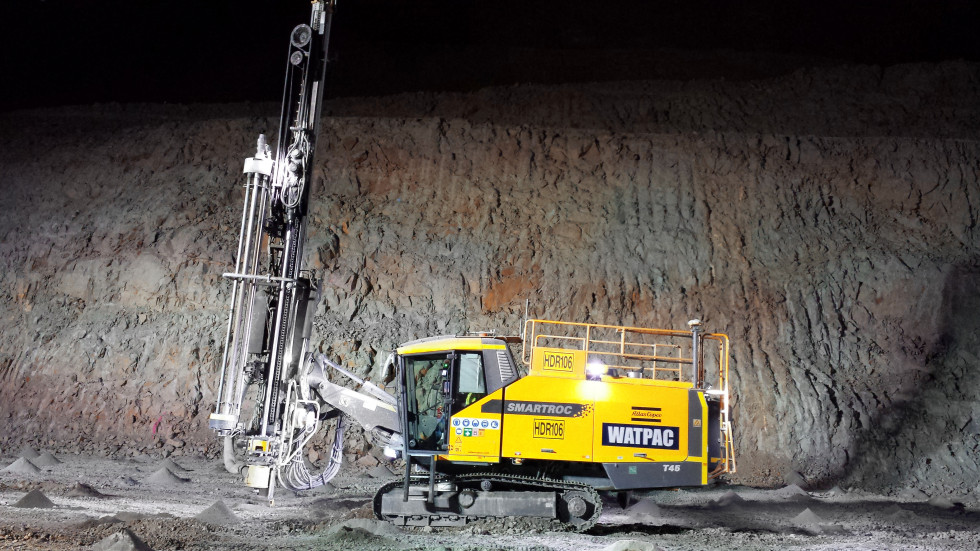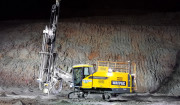With major clients in mining and secondary processing operations in Western Australia, Queensland and Victoria, Watpac Civil & Mining insists on the best tools to build and sustain competitive advantage.
As Brendan Vaughan, Mining Manager, says: ?The three cost drivers we have, and that we base our bids on, is the cost of the productivity to be achieved, the cost of the provider and the cost of the people. As a service, we have to be good in those three areas. But we can?t necessarily be good at everything, so our focus is to be the best with certain pieces of equipment within our business model.
?We want to be the best in Australia at operating equipment in the 100?200 tonne range, and that means understanding the lifecycle cost of the equipment better than anyone else.?
Vaughan says Watpac?s decision to expand its fleet of Atlas Copco SmartRig ROC F9 C tophammer drill rigs was not only based on the technology, but also on the support provided by Atlas Copco. It was also important that the two companies were able to work closely together on the application.
?Just because it works in the north of Sweden it doesn?t mean it can be started up at Mt Magnet in Western Australia, in the middle of summer, without the full attention of relevant technicians and expert,? he adds. ?I think my job as a responsible engineer and an officer of Watpac is to make sure we have a strategy that is fully supported from the manufacturer through to what we?re doing for our clients nationally, across multiple remote sites.
?We want to be innovative and we want to work with people who are innovative; that?s important to us. It?s about innovation that works. The SmartROC T45 drill has been an incredible piece of technology to put out there to our clients.?
Great fuel efficiency
Watpac has been putting Australia?s first SmartROC T45 through its paces at the Mt Magnet gold mine, owned by Ramelius Resources, in WA?s Murchison district. After three months on site, it was confirmed that it burns considerably less fuel than its predecessor, the SmartRig ROC F9 C.
Vaughan explains: ?That?s highly significant because if we get savings of 30% on fuel ? and we are seeing better than this ? it means that the engine is wearing out less quickly, and that has a tremendous impact on your lifecycle maintenance strategy for running the drill.
?There is always a big focus on engine life with these track-mounted machines. There is a direct correlation between fuel reduction and frame life, and that?s a much bigger saving. The fuel saving is just the tip of the iceberg.?
Vaughan says the promise of maintenance cost savings related to the simplified hose and fitting layout of the SmartROC?T45 was likely to become evident after 7?000 hours or so of operation. Higher drill penetration rates with the extra 5kW of rockdrill power (now 30kW) were also expected once some early rod changing challenges had been overcome.
?We put the SmartROC T45 in the hardest rocks ? basalts and dolerites ? and banded iron formations which are essentially the three types of drilling applications faced at
Mt Magnet,? Vaughan says. ?It?s not the granite and gneisses they test these rigs on in Sweden. Basalts and dolerites aren?t for the faint of heart, and BIFs (branded iron formations) tend to be dense and a little bit abrasive, too. It?s a good test application for the technology.?
Vaughan says the benefits of modern technology on board the new generation rigs, such as the Atlas Copco Rig Control System (RCS) and satellite-based hole navigation system (HNS), had been demonstrated with the SmartRig ROC F9 C and that these are now an integral part of Watpac?s productivity push going forward.
The HNS uses data from mine planning software to accurately guide and control setup without operator intervention, while gathering streams of useful information (hole depths, meters, penetration rates) during drilling. In full stride, the ?autonomous? drill rig does not require manual pit mark-ups and could ultimately be operated from outside the pit.
The happy people
?Some of the happiest people at Mt Magnet are the surveyors,? Vaughan says. ?They don?t have to go out and put a hole in the ground anymore. They can be off doing other things rather than setting up the drill and blast patterns, and our blast crews don?t have to mark the ground either.
?When I hear at our sites that ?we need to have our ground stations set up to be able to run our smart drill?, it is music to my ears. It means the technology is being used and we are getting the advantages from it.
?I think it is interesting where this technology is taking the industry. It?s made drilling possible for people who are less skilled. So if you add in the more powerful rock drills, and the improved lifecycle cost, and the other benefits, that?s what we?ll be able to pass directly back to our clients.?
Vaughan adds that the Atlas Copco support for the rigs has been first class. ?I haven?t heard of any occasion where they haven?t been there ready to respond to our needs, and that?s very important,? he said.
Vaughan said he could not confirm exactly when the SmartROC T45 trials would come to an end. ?I don?t think they?re going to get their drill rig back,? he said with a smile. ?They?ll have to ask me very nicely.?
Epiroc operated under the trademark “Atlas Copco” prior to January 1, 2018.




Here:
Us: